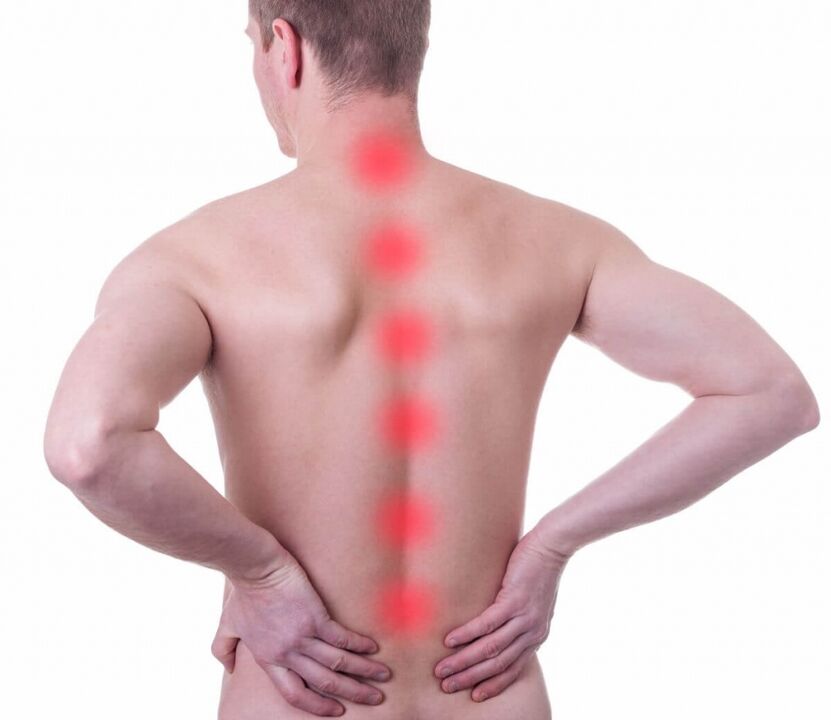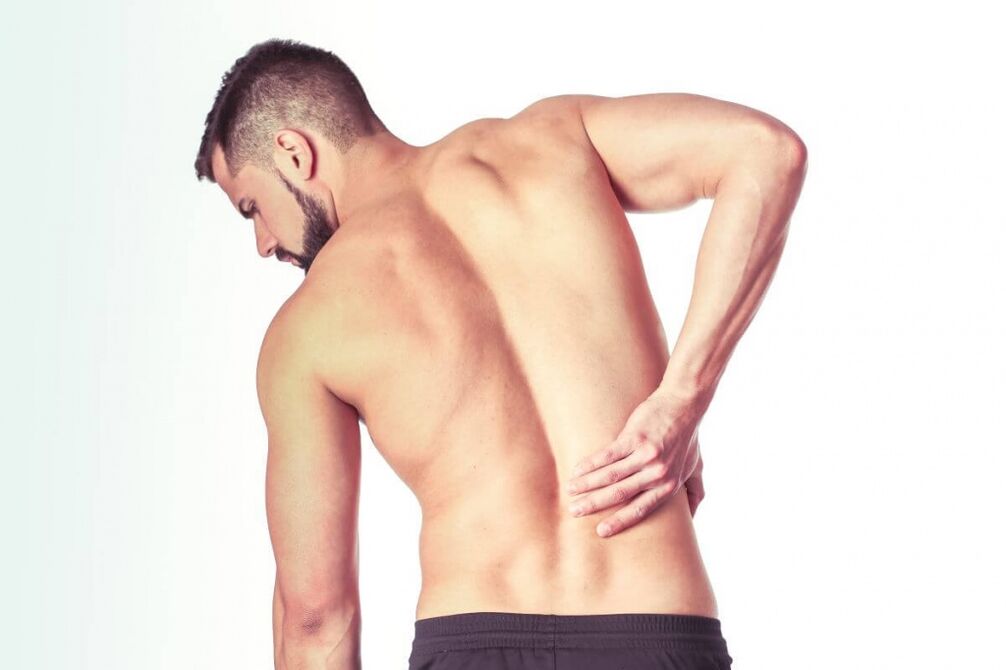Today, back pain is one of the common reasons why people seek qualified advice. According to some data, it happens at least once in a lifetime in at least 80% of the adult population, and at least 4-9% every year seek qualified advice about it. A painful sensation just above the lumbar region, in the back, is a common complaint. In this article we will talk about what problems can cause pain in this area, how it is identified, and also touch on the topic of combating them.
Some Possible Causes of Pain
Most cases of pain in the back and waist are musculoskeletal pain, which can be caused by osteochondrosis, myositis, and intervertebral hernia. However, it can also be caused by other pathologies, as well as certain conditions of the human body. Let's look at some common reasons.
Osteochondrosis
Or, according to the term adopted today in the international classification of diseases - dorsopathy. These are dystrophic changes in the cartilage tissue of the intervertebral disc, balancing the load on the spine, providing shock absorption during movement, vibration load, etc. In most cases, pathology can appear due to genetic predisposition, as well as inactivity and a sedentary lifestyle, and lack of physical activity.
Myalgia
This is a muscle pain that can be caused by a variety of reasons. Just above the lower back are the muscles that hold and stabilize the spinal column. Therefore, the cause of painful sensations in it can be various diseases of the spine itself, as well as increased physical activity, hypothermia, etc.
Intervertebral hernia
This is one of the complications of osteochondrosis of the spine, in which the integrity of the intervertebral disc is disturbed, and the aqueous core located inside protrudes into the spinal canal. Depending on the size of the hernia and its location on the back, a sharp shooting pain may occur, sometimes radiating to other parts of the body and limbs (with pathology above the lower back, this can be either a leg or an arm).
Diseases of internal organs
Back pain is not always a sign of a problem with the spine. Often it can also be a symptom of internal organ pathology: gastric and duodenal ulcers, pancreatitis, cholecystitis, urolithiasis, kidney disease, etc. However, it does not always hurt in the abdomen, flanks or other areas where the affected organ is located. .
Age-related changes
With age, the structure of the spine undergoes several changes, especially noticeable with a sedentary lifestyle and reduced loads. They involve ligaments, muscles, and bone tissue. Osteochondrosis and arthrosis, combined with muscle atrophy and loss of ligament elasticity, can periodically cause pain in the lumbar region.
Pregnancy
Back pain is not always a sign of any pathology. For example, late pregnancy can also cause this condition in women. According to available data, 90% of pregnant women complain of back pain and 50% of localized discomfort specifically in the lumbar region. But why does this happen? The reason is physiological changes in the biomechanics of the pelvis and spine. In most cases, pain can occur in women who have had back problems

A painful type of sensation
Understanding the type of pain a person is experiencing is important for diagnosis. Back pain above the lower back can be girdle, pain, pulling, dull, sharp, etc. Sensations are just additional data used in diagnosis. You should not rely entirely on them, let alone diagnose yourself based solely on this information.
Several possible diagnostic methods
During a qualified consultation, anamnesis and data about symptoms are collected. However, this is not enough: additional examinations are needed to make a more accurate diagnosis. The expert can either limit himself to one of them or prescribe several.
Radiography
This is a diagnostic technique based on the use of X-rays. With the help of such an examination, it is possible to identify fractures, osteochondrosis of the spine, spondylosis, neoplasms, as well as curvatures and other disorders. When performing radiography, the image of the studied organ is projected on film or paper in only one projection - this method is less informative than X-ray CT and MRI.
X-ray computed tomography (X-ray computed tomography)
X-ray CT is similar to radiography in the technology used: it is also based on x-ray radiation. However, as a result of such diagnostics, not 2D, but 3D images are obtained, which are available for layer-by-layer study. For this, stronger ionizing radiation is used, which should not be used too often. RCT can be performed with or without contrast, which provides a clearer image and improves the success of diagnosing certain diseases.
MRI
Magnetic resonance imaging is a diagnostic method that also allows one to obtain multilayer images in several projections, but is completely unrelated to the use of X-rays. It is based on magnetic resonance and is therefore safer than X-ray and CT scans, but is not suitable for patients with permanent metal structures in the body. In addition, these studies are noisier and longer. Like CT, MRI can be done differently by diagnosing certain diseases more accurately.
Ultrasound
This technique is based on the principle of echolocation and, as a rule, is used to diagnose diseases of internal organs if the symptoms give reason to suspect their presence. It is very informative and safe in the study of organs and tissues. Spinal ultrasound is also done, but very rarely.
Laboratory diagnostics
To diagnose the inflammatory process, the presence of infection or tumors, a general blood test with the ESR-leukocyte formula can be prescribed. In the future, if internal organ pathology is suspected, additional laboratory tests may also be prescribed.
Other diagnostic methods
If the specific nature of the pain or internal organ disease is suspected, other examinations may be prescribed until a diagnosis is made and the cause of the pain is identified.

Treatment of back pain above the lumbar region
The most important step in getting rid of back pain is getting qualified advice. After diagnosis, exclusion of diseases of internal organs, serious pathologies of the spine and determination of pain as non-specific, the following may be recommended:
- taking NSAIDs.Nonsteroidal anti-inflammatory drugs for internal and local use are often used to relieve non-specific back pain, osteochondrosis, hernia and other pathologies. The drug category includes the active ingredient in the composition - nimesulide;
- take muscle relaxants.They are designed to help fight muscle spasms, thereby increasing mobility and reducing pain;
- take other medicines.For diseases of internal organs or back pain during pregnancy, the set of drugs will most likely be different;
- physiotherapy and exercise therapy.During the acute period, various physical procedures may be recommended to relieve pain and speed improvement. These include, for example, electrophoresis with analgesics, pulsed current, ultraviolet irradiation, massage, exercise therapy, as well as mineral baths, mud therapy, etc. ;
- surgical intervention.Surgery can be prescribed for a herniated disc if other methods of pain relief do not produce results for a long time, and may also be indicated based on the results of MRI, X-ray or X-ray.

Some Possible Preventive Measures
Since the risk factors for the development of musculoskeletal back pain, including in the area above the lumbar region, include heavy physical work, an inactive lifestyle, as well as frequent bending of the body, heavy lifting and vibration, it is recommended to minimize these factors. as a preventive measure. If your back already hurts above the lower back, you should not immediately overload your muscles with gymnastics and especially sports - you should first seek qualified advice to rule out pathology.

























